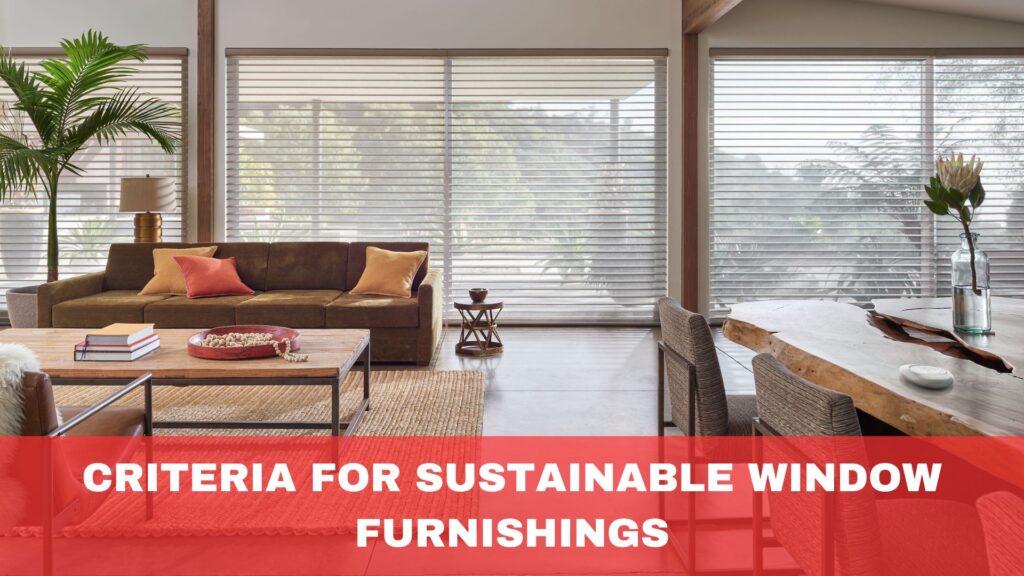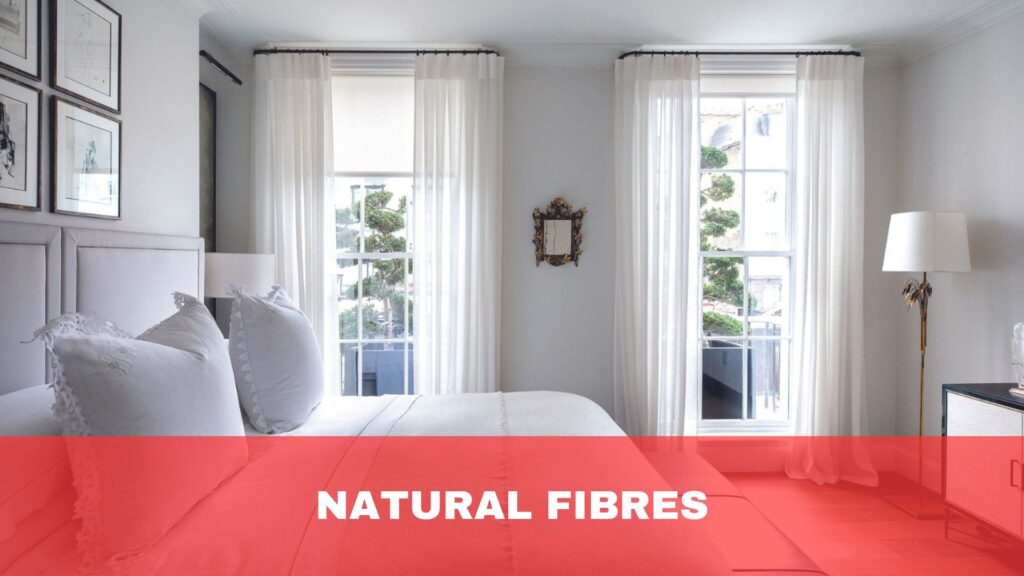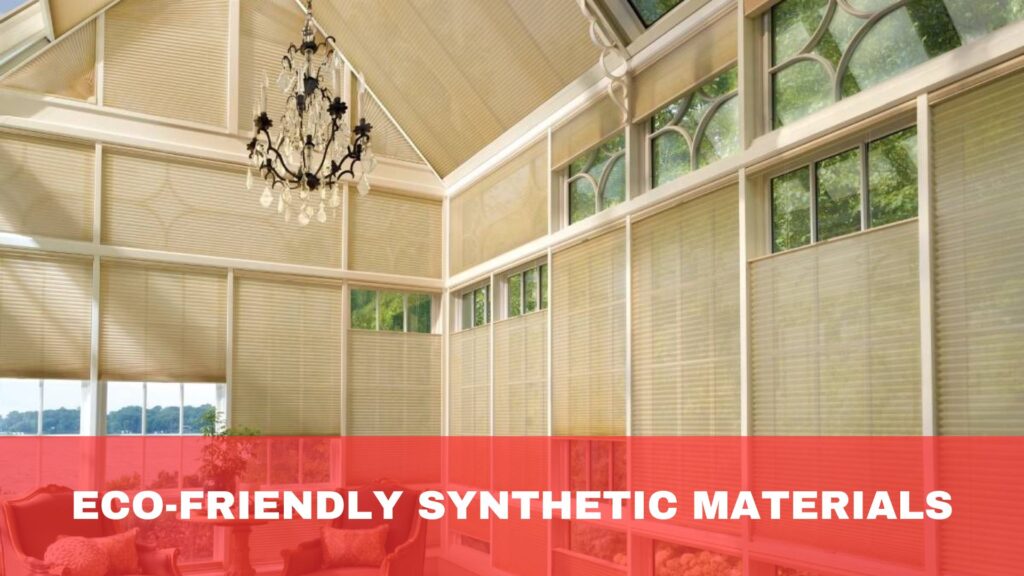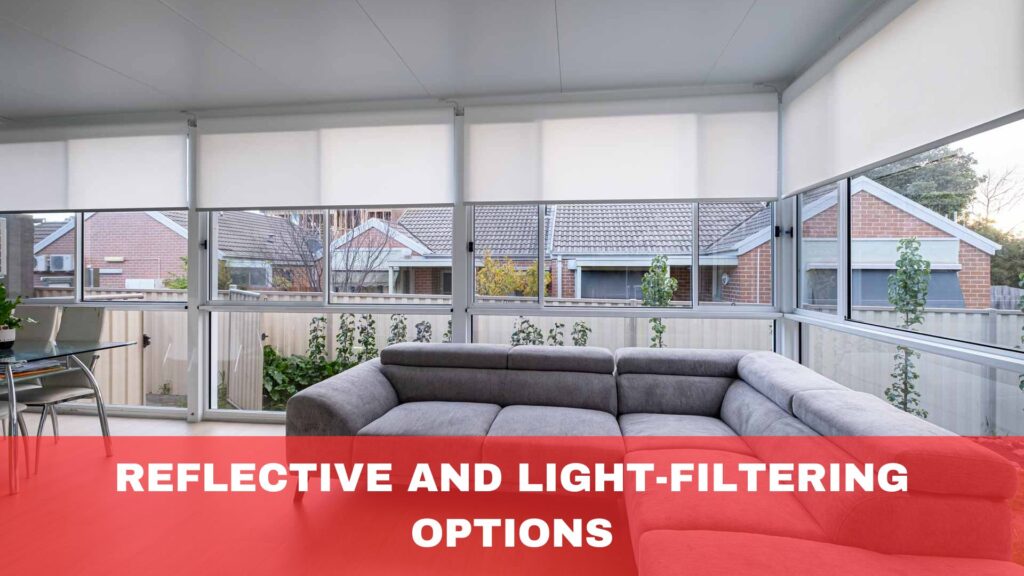Many overlook the environmental impact of window furnishings, which often contribute to energy consumption and waste.
Conventional options can strain resources and harm ecosystems, raising concerns about sustainability.
Explore how choosing eco-friendly window furnishings can mitigate environmental impact, offering both style and sustainability for conscientious living.
Criteria for Sustainable Window Furnishings

Choosing sustainable window furnishings involves considering several vital criteria. Firstly, selection is crucial; opt for natural and renewable materials such as organic cotton, linen, bamboo, or sustainably sourced wood like FSC-certified timber. These materials are biodegradable and have lower environmental impacts throughout their lifecycle.
Secondly, manufacturing processes play a significant role. Look for products made using energy-efficient methods and those with certifications like GreenGuard for low chemical emissions. This ensures reduced energy consumption and healthier indoor air quality.
Thirdly, durability and longevity are essential. Select window furnishings that are well-made and designed to last, reducing the frequency of replacements and landfill waste.
Additionally, the energy efficiency of the window coverings should be considered. Products with insulating properties can help regulate indoor temperatures, reducing the need for heating or cooling and thus lowering energy consumption.
Lastly, recyclability and end-of-life options are vital. To minimise environmental impact, choose furnishings that can be easily recycled or repurposed after use.
Sustainable Material Options
Choosing sustainable materials for window furnishings minimises environmental impact while enhancing your home’s aesthetics and functionality. Sustainable options reduce resource depletion, promote responsible manufacturing practices, and support circular economy principles.
Here are critical sustainable material options to consider when selecting window furnishings:
1. Natural Fibres

Natural fibres offer a sustainable alternative for window furnishings, combining environmental benefits with aesthetic appeal.
Cotton is a versatile choice, known for its softness and breathability. Opt for organic cotton to ensure minimal pesticide use and support sustainable farming practices.
Linen is another natural fibre renowned for its durability and natural elegance. Compared to conventional cotton, it requires less water and pesticides during cultivation, making it an eco-friendly option for curtains and blinds.
Hemp is gaining popularity for its robustness and sustainability. It overgrows without pesticides and enriches the soil, making it an excellent choice for eco-conscious homeowners.
Jute and sisal are natural fibres derived from plant stalks. They offer durability and a rustic charm. These fibres are biodegradable and have low environmental impact throughout their lifecycle.
2. Recycled Materials
Choosing window furnishings made from recycled materials is a proactive step towards reducing environmental impact and promoting sustainability.
PET fabrics from recycled plastic bottles offer a durable and eco-friendly alternative. These materials divert plastic waste from landfills and conserve energy and resources compared to producing new materials.
Recycled timber is another sustainable choice. Reusing wood from sources like old furniture or construction waste contributes to the circular economy. It also reduces deforestation and minimises the environmental footprint associated with new wood production.
Recycled aluminium is widely used for blinds and shutters due to its lightweight nature and durability. Recycling aluminium requires significantly less energy than producing new aluminium, making it a cost-effective and environmentally friendly option.
3. Eco-Friendly Synthetic Materials

Eco-friendly synthetic materials offer a viable option for sustainable window furnishings, combining modern innovation with environmental responsibility.
Recycled polyester, derived from post-consumer plastic bottles, is one such material. Compared to virgin polyester production, it reduces landfill waste and energy consumption while offering durability and versatility in blinds and curtains.
Polypropylene is another eco-friendly synthetic option known for its strength and resistance to moisture. It is suitable for humid environments like kitchens and bathrooms, and it is recyclable and requires less energy to produce than many natural fibres.
Nylon can also be eco-friendly when sourced responsibly and recycled. It offers durability and colour retention, which is ideal for long-lasting window coverings that minimise replacement frequency and waste.
Energy-Efficient Window Treatments
Selecting energy-efficient window treatments is pivotal for homeowners aiming to reduce their environmental footprint while enhancing indoor comfort. These innovative solutions regulate indoor temperatures and contribute significantly to energy conservation.
Here are critical types of energy-efficient window treatments that can transform your living space while promoting sustainability:
1. Insulating Blinds and Shades

Insulating blinds and shades are essential for sustainable window furnishings that improve home energy efficiency and comfort. These products feature specialised materials and construction, such as cellular or honeycomb designs, which create air pockets that trap heat in winter and block heat in summer. This thermal barrier reduces the need for heating and cooling, thus lowering energy consumption and associated costs.
Thermal-lined curtains also contribute to insulation by preventing heat loss through windows during colder months. They are effective at maintaining room temperatures and enhancing overall comfort.
When choosing insulating blinds and shades, consider their R-value, a measure of thermal resistance. Higher R-values indicate better insulation properties.
Additionally, look for products with energy-saving certifications or endorsements, ensuring they meet efficiency standards and contribute positively to sustainable living practices.
2. Reflective and Light-Filtering Options

Reflective and light-filtering window furnishings are essential for balancing natural light and heat gain, contributing to energy efficiency and home comfort.
Reflective blinds and films are designed to reflect sunlight and UV rays, preventing excessive solar heat gain during hot weather while maintaining a bright, well-lit interior. This helps reduce the need for air conditioning, thereby conserving energy.
Light-filtering blinds and shades offer a softer approach. They allow natural light to penetrate while diffusing harsh glare and UV rays. This option enhances indoor brightness and visibility without compromising privacy or heat control.
Choosing reflective and light-filtering options depends on the climate and specific room needs. In sunny regions, reflective solutions effectively reduce cooling costs, while light-filtering options provide a balanced environment throughout the day.
Longevity and Durability
Investing in window furnishings prioritising longevity and durability is crucial for sustainable living. High-quality materials and craftsmanship ensure that products withstand daily wear and tear, reducing the frequency of replacements and landfill waste.
Hardwood shutters and FSC-certified wood blinds exemplify durability, offering timeless elegance and robustness. These materials are sourced responsibly, promoting forest conservation and supporting sustainable forestry practices.
Metal blinds, such as aluminium or steel, are known for their strength and resistance to corrosion. This makes them suitable for high-moisture areas like kitchens and bathrooms. Their longevity reduces the need for replacements, contributing to resource efficiency.
Synthetic materials, like recycled PET fabrics or polypropylene, are also durable options. They resist fading, staining, and tearing, ensuring prolonged lifespan and minimal maintenance.
Sustainable Manufacturing Practices

Choosing window furnishings manufactured with sustainable practices is essential for reducing environmental impact and promoting ethical standards.
Look for products from companies committed to carbon-neutral operations and renewable energy sources in their manufacturing processes. These initiatives minimise greenhouse gas emissions and support cleaner energy alternatives.
Recycling programs and waste reduction strategies indicate a company’s commitment to sustainability. Manufacturers that use recycled materials or have efficient waste management systems contribute to a circular economy and minimise landfill waste.
Fairtrade practices and ethical sourcing of materials ensure that workers are treated fairly and that materials are responsibly harvested or produced. This supports social equity and environmental conservation efforts globally.
Disposal and Recycling
Considering the end-of-life disposal and recycling options for window furnishings is crucial for maintaining sustainability throughout their lifecycle.
Recyclable materials, such as aluminium, steel, and certain plastics, facilitate easier recycling processes at the end of their use. Look for products labelled with recycling symbols or statements from manufacturers supporting recycling initiatives.
Upcycling is another sustainable option where old window furnishings can be creatively repurposed into new products or materials. This reduces waste and extends the lifecycle of materials.
When replacing window furnishings, consider donating usable items to charity or organisations that can refurbish and reuse them. This reduces landfill waste and benefits community organisations.
Proper disposal methods should be followed for non-recyclable materials to minimise environmental impact. Check local waste management guidelines or consult recycling centres for appropriate disposal procedures.
Conclusion
By selecting sustainable window furnishings, we can actively reduce our ecological footprint while enhancing our living spaces.
Choose longevity products made from recycled materials and manufactured with eco-friendly practices. Let’s create homes that promote environmental stewardship and sustainable living for future generations.


